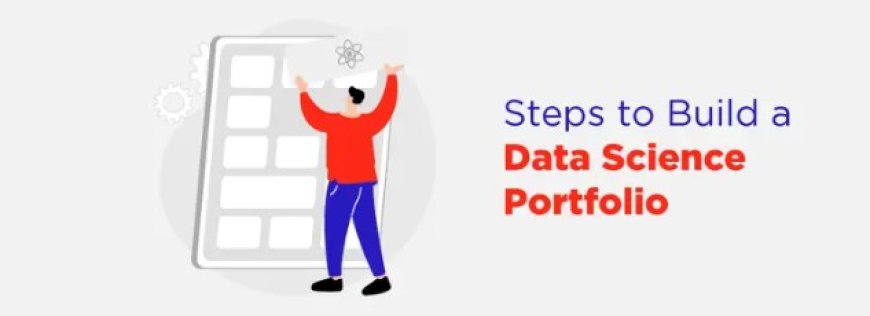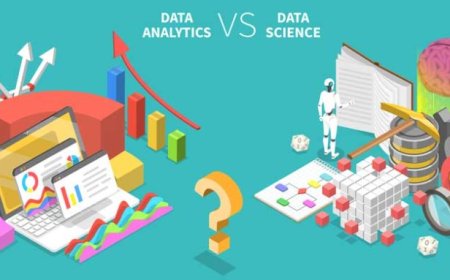A Step-by-Step Guide to Building a Data Science Portfolio
Learn how to create a compelling data science portfolio step by step. Get tips and examples to showcase your skills effectively.

A data science portfolio is like a showcase of your work that proves you're really good at it. It's super important, especially when you're looking for a job. Imagine it like a picture album you show to friends - but instead of pictures, it's all the cool data projects you've done.
When you're applying for a job, having a portfolio is like saying, "Hey, look at all the awesome stuff I can do!" It helps employers see your skills in action. They don't have to guess if you're good; they can see it for themselves.
You need to build your portfolio the right way. You can't just throw stuff in there randomly. You need a plan. That's where a structured approach comes in. It means having a clear plan for what projects to include and how to present them. This way, it's easy for anyone looking at your portfolio to understand what you've done.
Remember, a data science portfolio is your golden ticket to showing off your skills to potential employers. It's like your personal trophy case of awesome data projects! Just make sure you organize it well so that others can see your talent shine through.
Challenges and obstacles in building an effective data science portfolio
Building a strong data science portfolio can sometimes be tricky. There are a few things that can make it a bit complicated.
There are challenges and obstacles you might face. This could include finding the right projects to work on, or figuring out how to showcase your skills in the best way.
Secondly, it's important to know what employers and recruiters are looking for. They want to see that you can solve real-world problems using data. So, you need to make sure your portfolio demonstrates this.
You have to find a balance between practical projects and personal projects. Practical projects show you can handle real business problems. Personal projects, on the other hand, can reflect your interests and creativity. Striking the right balance between the two is important.
Remember, while practical projects are important, personal projects can also add a unique touch to your portfolio. They show your passion for data science and your ability to explore new ideas.
So, when you're working on your portfolio, think about these things. Overcoming challenges, understanding what employers want, and finding the right mix of projects will help you create a portfolio that really stands out.
What types of projects should be included in a data science portfolio?
Certainly! When you're putting together a data science portfolio, it's important to include a variety of projects that showcase your skills and interests. Here are some types of projects you should consider:
Predictive Modeling: This type of project involves using data to make predictions about future outcomes. For example, you could build a model to predict housing prices based on factors like location, size, and amenities.
Classification Projects: These involve sorting data into different categories. An example could be creating a spam filter for emails, where the model determines whether an incoming email is spam or not.
Clustering and Segmentation: This type of project groups similar data points together. For instance, you could use clustering to group customers based on their purchasing behavior.
Time Series Analysis: This involves studying data points collected over time to identify patterns or make predictions. For instance, you could analyze stock prices to predict future trends.
Natural Language Processing (NLP): NLP projects involve working with text data. You could build a sentiment analysis tool to determine whether a piece of text has a positive or negative tone.
Image Recognition: This type of project involves training models to recognize objects or patterns in images. For example, you could create a system that identifies different types of fruits in pictures.
Recommendation Systems: These projects focus on suggesting items or content to users based on their preferences. For example, you could build a movie recommendation system.
Anomaly Detection: This involves finding unusual patterns or outliers in data. An example could be identifying fraudulent transactions in a dataset of financial transactions.
Remember, it's a good idea to choose projects that align with your interests and demonstrate your ability to solve real-world problems. Additionally, make sure to explain your projects in a clear and understandable way in your portfolio. This will help potential employers or collaborators understand your skills and what you're capable of.
How to choose the right datasets for portfolio projects?
Choosing the right datasets for your data science portfolio projects is super important! The datasets you pick can make a big difference in how awesome your projects turn out. So, here's a simple guide to help you make smart choices.
-
Start with Your Interests: Begin by thinking about what interests you. Do you have a passion for sports, movies, finance, or any specific field? Start with a topic you care about. This makes the whole process more engaging and enjoyable.
-
Identify Your Goals: Determine what you want to achieve with your portfolio. Are you looking to showcase your ability to predict trends, make recommendations, or create visualizations? Knowing your goals will guide your dataset selection.
-
Consider Dataset Size: For beginners, it's usually a good idea to start with smaller datasets. Large datasets can be overwhelming and require more processing power. Smaller datasets allow you to focus on honing your skills.
-
Data Availability: Ensure that the data you want to work with is readily available. You can find datasets on websites like Kaggle, data.gov, or through APIs. Accessible data will save you time and frustration.
-
Data Quality: Check the quality of the dataset. Is it well-documented? Are there missing values or inconsistencies? High-quality data will make your analysis smoother and more reliable.
-
Data Diversity: Variety is key. Choose datasets that vary in terms of data types (e.g., numerical, text, images) and sources. This diversity will showcase your versatility as a data scientist.
-
Relevance to Your Goals: Ensure that the dataset aligns with your goals. If you aim to work on predictive modeling, a dataset with historical data and a target variable is essential. For visualization projects, a dataset with various attributes will be more suitable.
-
Legal and Ethical Considerations: Always respect copyright and privacy laws. Make sure you have the right to use the data for your projects. Anonymize any personal information to protect individuals' privacy.
-
Data Cleaning Requirements: Consider the amount of data cleaning and preprocessing the dataset may need. While some cleaning is expected, choose datasets that don't require extensive, time-consuming cleansing, especially for beginners.
To sum it up, choosing the right datasets is like picking the right ingredients for a recipe. Match your interests, start small, look for clean data, use reliable sources, align with your project goals, and always play fair with data. When you get these right, your portfolio projects will be top-notch!
Tools and technologies should be used in portfolio projects
When working on portfolio projects in data science, it's important to use tools and technologies that help you analyze and present your findings effectively. Here are some easy-to-use tools and tips for showcasing your skills:
-
Python or R: These are popular programming languages for data science. They have user-friendly libraries and resources that make it easier to work with data.
-
Jupyter Notebooks: They are like digital notebooks where you can write and run your code. They're great for showing your step-by-step process and results.
-
Pandas and NumPy: These libraries in Python help you handle and manipulate data. They're like special toolkits that make working with data much simpler.
-
Tableau or Power BI: These are visualization tools that help you create interactive charts and graphs. They're useful for making your findings easy to understand.
Data science skills through portfolio projects
To showcase your data science skills in a compelling way, focus on these simple and readable strategies.
-
clearly explain what each project is about. Make sure people understand the problem you're solving or the question you're answering. Use everyday language, not jargon.
-
show your work step by step. Describe how you collected and cleaned the data. Then, explain how you used it to reach your conclusions. Simple visuals can make this even clearer.
-
share your code and data. Platforms like GitHub are great for this. They let you demonstrate your technical abilities and allow others to see your process.
-
Lastly, write about your projects. Tell a story. Explain why this work is important and how it can be used in the real world. Good storytelling can make your portfolio memorable and engaging.
Remember, the goal is to make your projects easy for others to understand and appreciate. By using accessible tools and presenting your work in a clear and engaging way, you'll effectively showcase your data science skills in your portfolio.
Best practices for documentation and presentation
When it comes to showing your data science work, keeping things clear and easy to understand is essential. Here are some simple and helpful tips for how to explain your projects and present them:
-
Clear Descriptions: Write down what your project is about in simple terms. Imagine you're explaining it to a friend who doesn't know much about data science.
-
Show Your Work: Explain how you did things step by step. This helps others follow your process and see your skills.
-
Use Visuals: Pictures, graphs, and charts can make your work easier to grasp. They say a picture is worth a thousand words.
-
Tell a Story: Make your work like a story with a beginning, middle, and end. Start with a problem, explain how you tackled it, and share the results.
-
Plain Language: Avoid fancy or technical words if you can. Use simple words to explain complex ideas.
-
Example Code: Share your code in a way that others can understand. Explain what each part does and why you did it that way.
-
Think of Your Audience: Consider who will look at your work. Tailor your explanation to their level of knowledge.
A clean and organized presentation makes a better impression. Use headings, bullet points, and a clean layout.
Remember, your goal is to make your data science work easy for others to understand and appreciate. Good documentation and presentation can set you apart and help you succeed in the field.
Building a data science portfolio involves several key steps. First, choose diverse and interesting projects that showcase your skills. Then, communicate your work clearly by writing about your projects and creating visuals. Don't forget to balance your technical skills with soft skills, like teamwork and problem-solving. Building an online portfolio is a must. You can do this through a personal website or portfolio platforms. Share your portfolio with peers and mentors to get feedback and keep improving. A strong data science portfolio is vital for landing a job in this competitive field. It helps employers see what you can do and builds your professional reputation. So, follow these steps to create an effective portfolio and boost your data science career.






























































